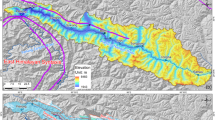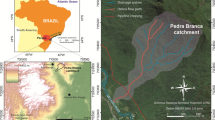Abstract
Extreme and prolonged rainfall in the Tunka Ridge caused several debris flows in the vicinity of the Arshan village (Siberia, Russia) on June 28, 2014. These debris flows, in spite of similar geological conditions, had different velocity, peak discharge and alluvial fan volume values. The flow velocity was from 3.5 m/s to 19.6 m/s, the peak discharge ranged from 63 m3/s to 13566 m3/s, and the alluvial fan volume varied from 4.13×103 to 8.45×105 m3. Such a great range of values is due to the morphometric parameters of the debris flow basins. The article deals with the influence of morphometric parameters of debris flow basins, such as the basin area, the average slope, Melton ratio, relief ratio on the debris flow velocity, peak discharge and volume of alluvial fans. In this debris flow event the average values of slope angle and total basin relief of the debris flow basins did not affect the values of debris flow velocity, peak discharge and alluvial fan volume. The highest correlations were observed with the debris flow basin area that was connected with the water inflow volume into the debris flow basins during the rainfall. The unequal water distribution among debris flow basins also had an impact on the debris flow velocity, peak discharge and volume of alluvial fans.
Similar content being viewed by others

References
Agafonov BP (1996) Cumulative debris flows in the Baikal region. Geomorphology 2: 27–36 (In Russian).
Aleotti P, Chowdhury R (1999) Landslide hazard assessment: summary review and new perspectives. Bulletin of Engineering Geology and the environment 58(1): 21–44. https://doi.org/10.1007/s100640050066
Allen SK, Rastner P, Arora M, et al. (2015) Lake outburst and debris flow disaster at Kedarnath, June 2013: hydrometeorological triggering and topographic predisposition. Landslides 13(6): 1479–1491. https://doi.org/10.1007/s10346-015-0584-3
Beven KJ, Kirkby MJ (1979) A physically based, variable contributing area model of basin hydrology. Hydrological Sciences Journal 24: 43–69.
Boudz MD (1968) Conditions of debris flow formation in the Baikal region. Proceedings of the 10th All-Union Conference on debris flows and mountain river processes. pp 291–296 (In Russian).
Bovis MJ, Jakob M (1999) The role of debris supply conditions in predicting debris flow activity. Earth Surface Process Landforms 24: 1039–1054
Breien H, De Blasio FV, Elverhøi A, et al. (2008) Erosion and morphology of a debris flow caused by a glacial lake outburst flood, western Norway. Landslides 5: 271–280. https://doi.org/10.1007/s10346-008-0118-3
Calcaterra D, Parise M, Palma B, et al. (2000) Multiple debris flows in volcaniclastic materials mantling carbonate slopes. Proceedings 2nd International Conference on “Debris-Flow Hazards Mitigation: Mechanics, Prediction, and Assessment”. Taiwan. pp 99–107.
Calcaterra D, Coppin D, de Vita S, et al. (2007) Slope processes in weathered volcaniclastic deposits within the city of Naples: the Camaldoli Hill case. Geomorphology 87: 132–157. http://doi.org/10.1016/j.geomorph.2006.03.040
Cannon SH, Kirkham RM, Parise M (2001) Wildfire-related debris-flow initiation processes, Storm King Mountain, Colorado. Geomorphology 39(3–4): 171–188. https://doi.org/10.1016/S0169-555X(00)00108-2
Cannon SH, Gartner JE, Parrett C, et al. (2003) Wildfire-related debris-flow generation through episodic progressive sediment bulking processes, western USA. In: Rickenmann D, Chen C (eds), “Debris-Flow Hazards Mitigation: Mechanics, Prediction, and Assessment”, Proceedings 3rd International Conference. Davos (Switzerland). 1: 71–82.
Chen HX, Zhang LM, Chang DS, et al. (2012) Mechanisms and runout characteristics of the rainfall-triggered debris flow in Xiaojiagou in Sichuan Province, China. Natural Hazards 62(3): 1037–1057. https://doi.org/10.1007/s11069-012-0133-5
Chiarle M, Iannotti S, Mortara G, et al. (2007) Recent debris flow occurrences associated with glaciers in the Alps. Global and Planetary Change 56(1): 123–136. https://doi.org/10.1016/j.gloplacha.2006.07.003
Coe JA, Godt JW, Parise M, et al. (2003) Estimating debris-flow probability using fan stratigraphy, historic records, and drainage-basin morphology, Interstate 70 highway corridor, central Colorado, U.S.A. In: Rickenmann D, Chen C (eds), “Debris-Flow Hazards Mitigation: Mechanics, Prediction, and Assessment”, Proceedings 3rd International Conference. Davos (Switzerland). 2: 1085–1096.
Costa JE (1988) Rheologic, Geomorphic and Sedimentologic differentiation of water floods, hyperconcentrated flows, and debris flows. Flood Geomorph 113–122.
Dimri AP, Thayyen RJ, Kibler K, et al. (2016) A review of atmospheric and land surface processes with emphasis on flood generation in the Southern Himalayan rivers. Science of the Total Environment 556: 98–115. https://doi.org/10.1016/j.scitotenv.2016.02.206
Dong JJ, Lee CT, Tung YH, et al. (2009) The role of the sediment budget in understanding debris flow susceptibility. Earth Surface Processes and Landforms 34(12): 1612–1624. https://doi.org/10.1002/esp.1850
Fu X, Wang G, Kang Z, et al. (2007) Planar velocity distribution of viscous debris flow at Jiangjia Ravine, Yunnan, China: A field measurement using two radar velocimeters. Wuhan University Journal of Natural Sciences 12(4): 583–587. https://doi.org/10.1007/s11859-006-0297-5
Furman MSh (1972) Meteorological monthly magazine, Issue 22, No. 13. Irkutsk Hydrometeorological Center: Irkutsk (In Russian)
Garfi G, Bruno D, Calcaterra D, et al. (2007) Fan morphodynamics and slope instability in the Mucone River basin (Sila Massif, southern Italy): significance of weathering and role of land use changes. Catena 69: 181–196. https://doi.org/10.1016/j.catena.2006.06.003
Haeberli W, Whiteman C (2015) Snow and Ice-Related Hazards, Risks, and Disasters: A General Framework. Snow and Ice-Related Hazards, Risks and Disasters. Springer.
Han Z, Chen G, Li Y, et al. (2015) Exploring the velocity distribution of debris flows: An iteration algorithm based approach for complex cross-sections. Geomorphology 241: 72–82. https://doi.org/10.1016/j.geomorph.2015.03.043
Hungr O, Evans S, Bovis M, et al. (2001) A review of the classification of landslides of the flow type Environmental and Engineering Geoscience 7(3): 221–238
Hürlimann M, Copons R, Altimir J (2006) Detailed debris flow hazard assessment in Andorra: a multidisciplinary approach. Geomorphology 78(3): 359–372. https://doi.org/10.1016/j.geomorph.2006.02.003
Iverson RM (1997) The physics of debris flows. Reviews of Geophysics 35: 245–296. https://doi.org/10.1029/97RG 00426
Iverson RM, Vallance JW (2001) New views of granular mass flows. Geology 29: 115–118. https://doi.org/10.1130/0091-7613(2001)029<0115:NVOGMF>2.0.CO;2
Jackson LE, Kostaschuk RA, Macdonald GM (1987) Identification of debris flow hazard on alluvial fans in the Canadian Rocky Mountains. Reviews in Engineering Geology 7: 115–124.
Jakob M, Hungr O, Jakob DM (2005) Debris-flow hazards and related phenomena. Springer: Berlin.
Jarvis A, Reuter HI, Nelson A, et al. (2008) Hole-filled seamless SRTM data V4, International Centre for Tropical Agriculture (CIAT). http://srtm.csi.cgiar.org (available at 27 October 2011)
Kadetova AV, Rybchenko AA, Kozireva EA, et al. (2016) Debris flows of 28 June 2014 near the Arshan village (Siberia, Republic of Buryatia, Russia). Landslides 13(1): 129–140. https://doi.org/10.1007/s10346-015-0661-7
Levi KG, Zadonina NV, Berdnikova NE, et al. (2002) 500-year chronology of anomalous phenomena in nature and society of Siberia and Mongolia. Irkutsk State Technical University: Irkutsk. (In Russian)
Liu CN, Huang SF, Dong JJ (2008) Impacts of September 21, 1999 Chi-Chi earthquake on the characteristics of gully-type debris flows in central Taiwan. Natural Hazards 47: 349–368. https://doi.org/10.1007/s11069-008-9223-9
Lo WC, Tsao TC, Hsu CH (2012) Building vulnerability to debris flows in Taiwan: a preliminary study. Natural hazards 64(3): 2107–2128. https://doi.org/10.1007/s11069-012-0124-6
Lvov A, Kropochev G (1909) Summary of the research carried out near the Arshan settlement on the instructions East Siberian Branch of the Russian Geographical Society. Proceedings of the Siberian Department of the Imperial Russian Geographical Society 40: 41–77 (In Russian).
Ma C, Hu K, Tian M (2013) Comparison of debris-flow volume and activity under different formation conditions. Natural hazards 67(2): 261–273. https://doi.org/10.1007/s11069-013-0557-6
Makarov SA (2012) Debris flows in the Cis-Baikalia. The V.B. Sochava Institute of Geography SB RAS: Irkutsk (In Russian)
Marchi L, Tecca PR (2013) Debris-flow monitoring in Italy. In: Schneuwly-Bollschweiler M, Stoffel M, Rudolf-Miklau F (eds), Dating Torrential Processes on Fans and Cones. Adv. Glob. Change Res. 47: 309–318.
Melton MA (1965) The geomorphic and paleoclimatic significance of alluvial deposits in southern Arizona. The Journal of Geology 1–38.
Montgomery DR, Dietrich WE (1992) Channel initiation and the problem of landscape scale. Science 225: 826–830.
Ni H, Zheng W, Li Z, et al. (2010) Recent catastrophic debris flows in Luding county, SW China: geological hazards, rainfall analysis and dynamic characteristics. Natural hazards 55(2): 523–542. https://doi.org/10.1007/s11069-010-9545-2
Palshin GB (1968) Engineering Geology of the Baikal region: Nauka, Moscow. (In Russian)
Perov VF (2012) Mudflow research. Study Guide. MSU Faculty of Geography: Moscow (In Russian).
Pierson TC, Costa JE (1987) A rheologic classification of subaerial sediment-water flows. In: Geological Society of America Reviews in Eng. Geol. 7: 1–12.
Plyusnin VM, Kitov AD (2010) Dynamics of nival-glacial systems of the south of Eastern Siberia. Ice and Snow 2: 5–11 (In Russian).
Portilla M, Chevalier GG, Hurlimann ZM (2010) Description and analysis of the debris flows occurred during 2008 in the Eastern Pyrenees. Natural hazards and Earth system sciences 10(7): 1635–1645. https://doi.org/10.5194/nhess-10-1635-2010
Prochaska AB, Santi PM, Higgins JD, et al. (2008) A study of methods to estimate debris flow velocity. Landslides 5(4): 431–444. https://doi.org/10.1007/s10346-008-0137-0
Rickenmann D (1999) Empirical relationships for debris flows. Natural hazards 19(1): 47–77. https://doi.org/10.1023/A:1008064220727
Rickenmann D (2005) Run-out prediction methods. In Jakob M and Hungr O (Eds), Debris-flow Hazards and Related Phenomena. Springer, Berlin. pp 305–324.
Ritter DF, Kochel RC, Miller JR (1995) The drainage basin. Process Geomorphology. William C. Brown: Dubuque.
Schilirò L, De Blasio FV, Esposito C, et al. (2015) Reconstruction of a destructive debris-flow event via numerical modeling: the role of valley geometry on flow dynamics. Earth Surface Processes and Landforms 40(14): 1847–1861. https://doi.org/10.1002/esp.3762
Sepúlveda SA, Moreiras SM, Lara M, et al. (2015) Debris flows in the Andean ranges of central Chile and Argentina triggered by 2013 summer storms: characteristics and consequences. Landslides 12(1): 115–133. https://doi.org/10.1007/s10346-014-0539-0
Shetnikov AA (2001) Geomorphology of Tunka rift. Geomorphology 2: 93–103 (In Russian).
Simoni A, Mammoliti M, Berti M (2011) Uncertainty of debris flow mobility relationships and its influence on the prediction of inundated areas. Geomorphology 132: 249–259. https://doi.org/10.1016/j.geomorph.2011.05.013
Sosio R, Crosta GB, Frattini P (2007) Field observations, rheological testing and numerical modelling of a debris-flow event. Earth Surface Proceses and Landforms 32: 290–306. https://doi.org/10.1002/esp.1391
Staley DM, Kean JW, Cannon SH, et al. (2013) Objective definition of rainfall intensity-duration thresholds for the initiation of post-fire debris flows in southern California. Landslides 10(5): 547–562. https://doi.org/10.1007/s10346-012-0341-9
Sumburgh AL (1971) Geological map of the Soviet Union. 1: 200000. East Sayan. Sheet M-48-I. Explanatory note. Moscow (In Russian)
Tang C, Zhu J, Li WL (2009) Rainfall-triggered debris flows following the Wenchuan earthquake. Bulletin of Engineering Geology and the Environment 68(2): 187–194. https://doi. org/10.1007/s10064-009-0201-6
Tecca PR, Genevois R (2009) Field observations of the June 30, 2001 debris flow at Acquabona (Dolomites, Italy). Landslides 6(1): 39–45. https://doi.org/10.1007/s10346-009-0145-8
Tiranti D, Cremonini R, Marco F, et al. (2014) The DEFENSE (debris Flows triggered by storms-nowcasting system): An early warning system for torrential processes by radar storm tracking using a Geographic Information System (GIS). Computers & Geosciences 70: 96–109. https://doi.org/10.1016/j.cageo.2014.05.004
Ufimtsev GF, Shchetnikov AA (2003) The Tunka Rift. Priroda 8: 43–49 (In Russian)
Vennari C, Santangelo N, Santo A, et al. (2016) A database on flash flood events in Campania, southern Italy, with an evaluation of their spatial and temporal distribution. Natural Hazards and Earth System Sciences 16: 2485–2500. https://doi.org/10.5194/nhess-16-2485-2016
Volkwein A, Wendeler C, Guasti G (2011) Design of flexible debris flow barriers. 5th International Conference debris-flow hazard mitigation. Mechanics, prediction and assessment. Padua, Italy. pp 1093–1100 https://doi.org/10.4408/IJEGE. 2011-03.B-118
Wilford DJ, Sakals ME, Innes JL, et al. (2004) Recognition of debris flow, debris flood and flood hazard through watershed morphometrics. Landslides 1(1): 61–66. https://doi.org/10.1007/s10346-003-0002-0
Yang H, Wei F, Hu K (2014) Mean velocity estimation of viscous debris flows. Journal of Earth Science 25(4): 771–778. https://doi.org/10.1007/s12583-014-0465-z
Yune CY, Chae YK, Paik J, et al. (2013) Debris flow in metropolitan area-2011 Seoul debris flow. Journal of Mountain Science 10(2): 199–206. https://doi.org/10.1007/ns11629-013-2518-7
Acknowledgements
We thank the employees of the "Tunkinskiy" National Park for assistance in the field work.
Author information
Authors and Affiliations
Corresponding author
Rights and permissions
About this article
Cite this article
Rybchenko, A.A., Kadetova, A.V. & Kozireva, E.A. Relation between basin morphometric features and dynamic characteristics of debris flows – a case study in Siberia, Russia. J. Mt. Sci. 15, 618–630 (2018). https://doi.org/10.1007/s11629-017-4547-0
Received:
Revised:
Accepted:
Published:
Issue Date:
DOI: https://doi.org/10.1007/s11629-017-4547-0



